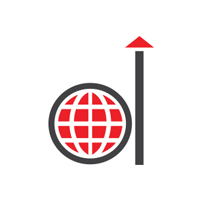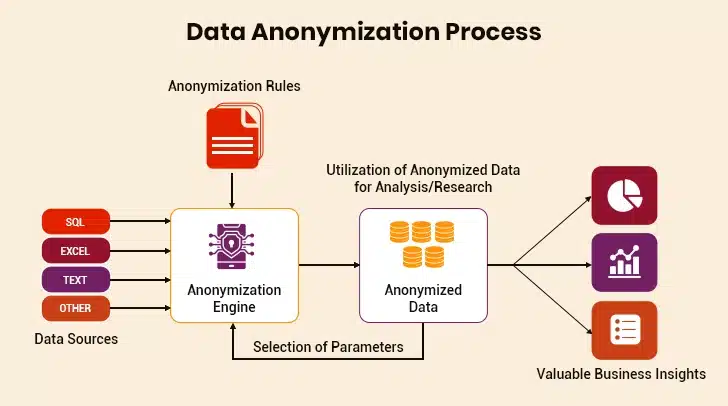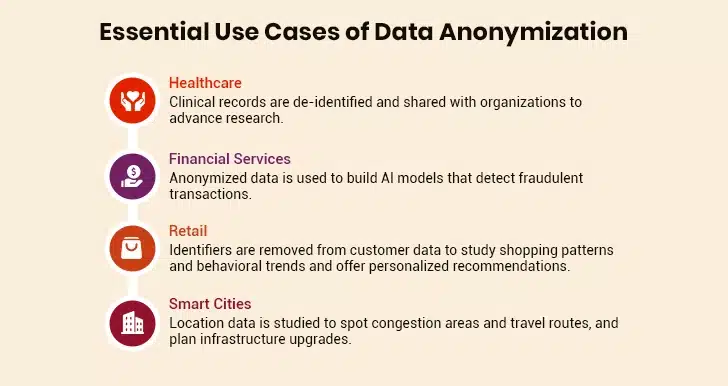Privacy is fundamentally vulnerable. Basic personal details can uniquely identify most individuals today. This is a systemic issue in how data is handled.
Data anonymization solves this challenge while adding business value. However, protecting sensitive information goes beyond ethics; it makes financial sense, too. By correctly anonymizing its information, organizations are able to make profits out of their data assets without incurring any legal restraint. The anonymized data is exempt from any rigid privacy laws. This enables flexibility in analytics processing and unlimited storage. However, one does not get cost savings as the only advantage. Anonymization helps build cross-border data partnerships that were previously blocked by privacy laws. Innovators in technology rely on secure data sharing to speed up research and safeguard user privacy.
Today, anonymization has moved from a compliance checkbox to a valuable business tool. Companies that get this right protect privacy, cut costs, and build new revenue streams.
This blog explains how data anonymization works as a business enabler and why smart organizations are treating it as an opportunity rather than an obligation.
Table of Contents
Understanding Data Anonymization
Anonymization as a Business Enabler: Key Advantages
Barriers to Scaling Data Anonymization and Their Solutions
Executive Framework: How to Deploy Anonymization Strategically
Understanding Data Anonymization
Data anonymization involves irreversibly removing or altering personal identifiers from datasets. This prevents individuals from being re-identified, even when combined with other data. It differs from pseudonymization (which allows re-identification), as it provides stronger privacy protection. Organizations use anonymization to comply with regulations like GDPR while safely analyzing sensitive customer, employee, or partner data. It reduces risks such as identity theft and fraud if there is a data breach.
Here are a few techniques commonly used in anonymization:
- Data Masking: Replaces real values with altered ones. Creates realistic but fake datasets for safe testing.
- Synthetic Data: Generates artificial data mimicking statistical patterns of real datasets. Enables analysis without exposing actual personal details.
- Generalization: Replaces specifics with broader categories (e.g., exact ages changed to age ranges). Preserves utility while reducing identifiability.
- Data Swapping: Swaps values between records (e.g., swapping salaries across employee entries). Protects individual privacy while maintaining overall accuracy.
Anonymization as a Business Enabler: Key Advantages
“The companies that do the best job on managing a user’s privacy will be the companies that ultimately are the most successful.”
-Fred Wilson, American businessman and venture capitalist
Anonymization provides advantages that go way beyond meeting regulations. Companies create business value through many channels. This way, privacy becomes a competitive advantage.
1. Cost Reduction and Operational Efficiency
The anonymization of data affects finances substantially. Companies can cut down on operating costs when they use anonymization tools and techniques. These savings come from many sources:
- Businesses need to implement fewer security measures.
- The compliance burden is considerably reduced.
- Anonymized datasets can be stored easily.
Anonymization also speeds up data collection and analysis. Teams spend less time on compliance paperwork and more time analyzing data. That efficiency boost happens because many regulatory barriers disappear when personal data processing is removed from the equation.
2. Expanded Data Utilization and Innovation
Organizations can use properly anonymized data for analytics, product development, and marketing strategies. They gain maximum value from this information without privacy concerns. Research shows that companies that leverage anonymized data innovate much faster compared to those that do not. This gives them an advantage over their competitors.
Anonymization allows companies to share data with their partners safely. There is little risk of sensitive information falling into the hands of unauthorized users. This proves useful in domains such as:
- Retail: Retail companies can process de-identified data to provide better product recommendations and gain customer insights.
- Financial Services: Banks can use anonymized datasets to improve fraud detection and prevention.
- Software Development: Technology companies can verify if their applications work properly using realistic but safe data.
3. Risk Mitigation and Security Enhancement
Anonymization protects against various threats. The Verizon Data Breach Investigations Report shows that insiders cause about 22% of security incidents. Organizations can prevent accidental exposure or misuse by authorized users through anonymization.
When security breaches happen, anonymized data reduces potential damage. This is because the information cannot be used by attackers in a meaningful manner. This protection reduces immediate financial losses. It also prevents long-term reputation damage that follows data exposure incidents.
4. Enhanced Trust and Market Positioning
Privacy-conscious customers tend to notice companies that protect data well. Organizations that invest heavily in anonymization earn customer trust. This trust often leads to measurable business outcomes: customers feel more comfortable sharing their personal details with companies that are perceived as privacy leaders. This ethically gathered data then fuels better insights. It also helps create personalized experiences and stronger customer relationships.
5. Unrestricted Data Analysis and Storage
Anonymized datasets can be stored indefinitely. This allows research teams to conduct longitudinal analyses where the same individuals are repeatedly observed over a period of time. Extended timelines allow researchers to study long-term trends and patterns that provide deeper insights. This kind of information would be impossible to capture under standard data retention policies.
Since anonymized data falls outside many regulatory frameworks, teams can analyze information across broader parameters without worrying about legal issues. This regulatory flexibility speeds up decision-making. It also empowers data scientists to pursue new analytical approaches.
Anonymization has thus evolved from a simple compliance tool to a strategic asset. It protects privacy and improves operations. It also creates new opportunities for growth.
The Impact of Data Engineering: Translating Information Overload to Business Growth
Barriers to Scaling Data Anonymization and Their Solutions
Anonymization of data brings many benefits. However, scaling these solutions may involve challenges. Companies need to tackle these hurdles to tap into the potential of anonymization without putting data integrity at risk.
I. Utility-Privacy Trade-Off
The biggest problem with anonymization is creating a balance between privacy protection and data usefulness. Research shows that data can be useful or completely anonymous, but not both at the same time. This creates a constant tug-of-war that needs careful handling.
Overly aggressive privacy measures may wipe out a lot of important information. This creates datasets that drift significantly from the original data. Many times, a big percentage of predictor variables are removed when users try to eliminate the risk of re-identification. The resulting loss of data undermines model accuracy and utility.
Here’s what companies can do about it:
- Measure the trade-off between privacy and data utility in monetary terms
- Pick anonymization methods that fit specific business needs
- Use approaches that combine different anonymization methods
II. Re-Identification Risks
Remember when removing names and social security numbers felt like enough protection? Those days are long gone. Research shows that just four random points can identify 95% of individuals within a dataset. This shows how easy it is to tamper with valuable data.
Re-identification threats have been raising because of following reasons:
- Linkage attacks that connect multiple datasets to expose identities
- Machine learning techniques that detect individual patterns
- External information sources that provide contextual clues
Businesses can combine anonymization with other data security techniques (encryption or erasure) to reduce the risk.
III. Cost and Complexity of Deployment
Implementation of anonymization involves a range of challenges. Advanced anonymization techniques require specialized expertise, which most small-sized companies do not have. Also, anonymization is not a one-time exercise. It requires continuous adaptation to new types of data, emerging technologies, and the evolving threat landscape.
Data anonymization services address these issues through:
- AI models that identify sensitive attributes across datasets
- Workflow management tools that standardize processes
- Anonymization platforms that get the work done while ensuring compliance
Solving these challenges allows organizations to implement anonymization at scale while maintaining data utility. That said, effective anonymization needs constant attention as privacy threats and de-identification technologies keep advancing.
Data Anonymization Use Cases
Anonymization helps organizations turn data privacy requirements into new revenue streams. These use cases show how companies protect their data while staying profitable.
1. Healthcare: HIPAA-Compliant Research
Anonymization of healthcare data protects patient privacy and supports vital research. To cite an example, Mayo Clinic uses an AI platform to de-identify clinical records securely. This anonymized data has helped identify early COVID-19 symptoms like anosmia. Mayo now offers this curated data to healthcare innovators through its Platform Discover service to advance research and discovery.
The Children’s Hospital of Philadelphia is building a cloud-based data-sharing platform. The platform aims to help clinicians access de-identified data on pediatric cancer patients for faster, better research. Together, these efforts break regulatory barriers and speed up discoveries.
2. Financial Services: Fraud Detection
Banking institutions anonymize data to detect fraud. They remove identifiers such as names and account numbers to safely analyze transactions without violating GDPR consent rules. This stripped-down data trains AI systems to find suspicious activity faster and more accurately. Banks also share these anonymized fraud patterns with each other; this helps them all identify new scams. With smarter, better-trained algorithms, these financial institutions cut down on false alarms. As a result, their employees have more time to focus on real problems.
3. Retail: Personalized Marketing
Retailers struggle to get specific customer consent for using their data. Anonymization eases the constraint by securely removing personal identifiers. This allows retailers to study aggregated shopping patterns and behavioral trends. They then use these insights to improve product recommendations. They can also target the right customer groups through advertisements. There is no risk of confidential data getting exposed to unauthorized users.
Retail companies also use these findings to create new products and improve website experiences. They can share this data securely with outside parties to gain additional insights.
4. Smart Cities: Traffic Optimization
Cities use anonymized location data to improve traffic flow while protecting privacy. By stripping personal details from mobile and vehicle signals, planners safely analyze aggregated movement patterns. This reveals peak congestion areas and travel routes without tracking individuals. Infrastructure upgrades such as road expansions or new transit lines are then planned depending on where they are needed the most. Real-time traffic light adjustments based on anonymous flow data reduce delays at intersections. Lower congestion cuts vehicle emissions significantly. These privacy-safe approaches thus make urban mobility more efficient and sustainable.
Executive Framework: How to Deploy Anonymization Strategically
Implementing data anonymization needs a systematic approach that creates a balance between privacy protection and business utility. Here are some of the steps business executives can take:
I. Classify Data by Sensitivity and Use Case
Organizations must first map their entire data landscape. They should identify and classify data elements based on sensitivity levels and regulatory requirements. For example, credit card numbers need different treatment from browsing patterns. Or, customer emails require stronger protection than their anonymized purchase totals. A full picture of the data helps select appropriate anonymization techniques. It also ensures adequate protection for sensitive information.
Data discovery tools can automate this process. These tools remove the need for manual oversight. They also boost the productivity of data engineers.
II. Match Techniques to Business Goals
The anonymization techniques chosen must align with pre-defined business objectives. Teams should consider the data’s characteristics, its intended use case, and the critical privacy-utility balance when selecting these techniques. To cite an instance, data destined for deep analytical research might need differential privacy, whereas routine internal reports could work with basic masking or generalization. Such an approach makes sure anonymization improves business efficiency rather than hindering progress.
III. Combine Techniques to Boost Defense
An effective anonymization strategy uses a layered approach that combines multiple techniques. Organizations can apply a mix of methods, such as data masking and generalization. This approach maintains data utility. It also reduces the risk of re-identification.
Teams can:
- Use differential privacy to add controlled random noise
- Reduce data granularity in sensitive fields
- Apply pseudonymization in combination with other methods
IV. Validate with Attack Simulations
Businesses must confirm the effectiveness of anonymization by implementing holistic attack simulations. The tests effectively analyze different security controls against new threats. Furthermore, it also enables weak spots to be quickly explored. Experts believe that automated testing is highly advantageous in comparison with manual methodologies. Businesses should prioritize the specific goals of these simulations. Their results assist in determining the effectiveness of security control as well as the general anonymization architecture.
V. Embed Privacy by Design
Organizations should adopt “Privacy by Design” principles that embed data protection from day one. This proactive approach puts privacy protection first during development and implementation instead of adding it later. Teams should conduct privacy impact assessments, choose privacy-enhancing technologies, and set up strong encryption and access controls.
One should always remember that anonymization isn’t a one-time project. It requires continuous monitoring and improvement. Regular updates keep solutions in line with changing privacy requirements and best practices.
Why Your Enterprise Data Management Strategy Needs a Maturity Assessment
Future Outlook: Where Anonymization Is Heading
Data anonymization technology is evolving at a rapid pace. AI and decentralized computing are changing how we handle user privacy.
1. AI-Powered Privacy
NLP technologies have changed how companies handle data. AI-powered anonymization tools now scan datasets automatically. They identify and redact sensitive information without human input. This makes the process more efficient and lets companies anonymize big datasets with fewer mistakes.
Today, advanced solutions such as Azure AI Language use smart algorithms to find personally identifiable information (PII) in several preset categories. These systems do more than spot obvious identifiers. They understand context, which helps reduce false positives and makes detection more accurate.
Amazon Comprehend uses machine learning to spot and flag sensitive information in reviews and social posts. These tools work better than rule-based systems, which may not be able to understand hidden meanings in text data.
Advanced AI anonymization tools adapt to new threats almost instantly. These tools find out weak spots and adjust anonymization techniques in real time. This helps reduce the risk of re-identification. Plus, they can handle multiple data streams at any given time. This makes them valuable for enterprises that deal with massive amounts of sensitive information.
2. Federated Learning
Federated learning brings a new approach to privacy protection. Here, machine learning models are trained across multiple devices or organizations without centralizing sensitive data. The raw information never leaves its original location.
This solves a fundamental privacy problem: data stays put. Organizations can collaborate on model development and share model updates to a central server. There is no need to expose sensitive information. This works especially well in regulated industries such as healthcare and finance, where data sharing has strict rules.
Teams can use federated learning along with differential privacy for even better data protection. When controlled noise is added to model updates, no one can work backward from the final model to local data. This helps boost data privacy.
Companies regularly test these advanced technologies to stay ahead of regulations and customer expectations. As these tools get better, they’ll change how businesses think about the balance between privacy and utility.
The Final Word
Data anonymization has emerged as a smart approach that companies cannot afford to ignore. Today, businesses of all sizes use anonymization strategies to safeguard sensitive information and create value.
Effective anonymization does a lot more than meet regulations. Companies that utilize anonymization reduce operational costs. They collect valuable data faster. They also process information without legal restrictions. The best part? They are able to earn customer trust. Users share their data freely, and this often leads to better analysis and stronger business relationships.
Despite these benefits, scaling anonymization can be difficult. Businesses need to maintain a balance between privacy and utility. They also need to safeguard themselves from evolving re-identification risks. Besides, implementation can easily get complex.
Nevertheless, these challenges have solutions. Companies that combine multiple techniques, test their systems regularly, and keep track of new threats can put these concerns to rest.
Needless to say, the anonymization of data has moved beyond compliance into strategic territory. Organizations that view privacy protection as an opportunity stand to gain significant advantages. Or put another way, in today’s data-powered economy, companies that balance privacy protection with data utility will emerge as industry leaders.








